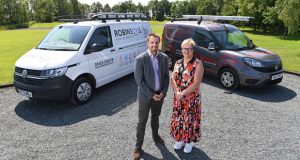The heatwave that has gripped Europe this summer has been linked to the impact of global warming and brings the role of the built environment in helping to slash emissions into focus. With the UK bringing in a law to introduce a legally-binding net zero emission target for 2050, what should FMs now be doing to help achieve these targets?
 THE SUSTAINABLITY EXPERT’S VIEW
THE SUSTAINABLITY EXPERT’S VIEW
SUNIL SHAH,
DIRECTOR AT ACCLARO ADVISORY AND CBXCHANGE
The UK is the first major economy to put into legislation a net zero emissions target for 2050, balancing the requests from the Extinction Rebellion to pull it forward and the Global Warming Policy Forum to remove it altogether. The target was set based upon the work from the Committee on Climate Change (CCC), who have mapped out the necessary milestones to achieve this target (www.theccc.org.uk/).
For the built environment, which contributes about 40 per cent of the UK’s total carbon footprint (www.ukgbc.org/climate-change/), there is a significant challenge to optimise and upgrade the existing building stock by 2050 – one property every 30 seconds. For much of the past 15 years, I have been commenting on the lack of a coherent Government policy, focussed too much on new build rather than on energy efficiency, building optimisation and learning lessons from operations to feed into new design.
Progress over the past decade have been patchy and limited. The Building Performance Evaluation (BPE) study (www.gov.uk/government/publications/low-carbon-buildings-best-practices-and-what-to-avoid) highlighted significant gaps in optimising energy from simple things such as meters, commissioning equipment and effective use of technology. In general there is a poor take up of these practices. Our own studies (www.acclaro-advisory.com/sfmi/) has shown limited progress by FM to develop beyond regulatory requirements for a variety of reasons.
There are five key areas FM teams should be looking at to help meet these targets. These are aligned with the CCC and BPE outputs, each of which are interconnected:
➤ Set longer term targets – strategic buy-in from the business to significantly reduce emissions, with FM being part of the overall programme. Robust data to understand how and why energy is used is critical here to develop a strategy aligned with the business culture;
➤ Heat – heat demand has reduced and there is a desire to move towards district or electric heating systems, rather than gas. Reduced consumption can occur from modulating for current systems and resizing for any replacement;
➤ Optimising buildings – ensuring the correct skills are in place and the contracts allow for optimising to be maintained are critical points. Too often, significant improvements are lost due to incorrect structures being in place;
➤ Climate risk – review the portfolio for their ability to cope with higher temperatures and changing weather. This will influence lease lengths, but also business continuity practices to cope with the risks and input into the capital investment plans;
➤ Supply chain emissions – wider impacts from suppliers including food and equipment are not factored into the wider impact that organisations make (https://ghgprotocol.org/). FM has a broader supply chain emissions potential to support the net zero targets.
The agreement by Government to move towards a zero carbon trajectory will mean the built environment will need to achieve net zero shortly after 2040 according to the CCC. This is within the timeframes for capital spend programmes and will have to influence how decisions are made. FM is at a crossroads and has a choice between cost cutting and tick box responses against being a responsible business.
 THE FM PROVIDER’S VIEW
THE FM PROVIDER’S VIEW
JOHN BURGESS,
ACCOUNT MANAGER AT CORPORATE OFFICE FM SPECIALIST ANABAS
FM’s are key to reducing a building’s carbon footprint and running costs. Technology has paved the way, making big changes easier to implement, from renewable energy sources such as windmills and solar panelling on rooftops, to switching to low energy light bulbs and intelligent lighting control systems. However, there is more that can be done and FM’s need to focus on small details and changes which can still make a big difference.
Beginning with the basics and using resources more wisely to limit use is not rocket science. It is a win – win, saving money for clients and reducing emissions at the same time and understanding the occupants and how they use a building is the first step. When it comes to energy consumption, it is always possible to “reduce the use”. Modern and refurbished buildings typically use Lighting Control Systems, but all too often they are not monitored regularly to ensure they are operating efficiently. As well as lighting, it is not uncommon for computer monitors, printers and photocopiers around the building to be left on. A simple solution to combat this is for the night security team to regularly monitor and log any machines left on, as well as turning them off where they can during their patrol. This just requires some training, focus and correct management. No cost, just knowledge. Turning common place floor patrols into turning everything off checks.
An additional quick win and cost saving can also be made by adjusting air con or heating schedules to turn on fifteen minutes later and turn off fifteen minutes earlier.
Thinking and working smarter can also make a difference. At Anabas we are about to introduce a new initiative with our corporate clients, switching from traditional office cleaning to flow cleaning. This project will increase productivity, reduce labour costs, and by working in groups, will reduce lighting usage around the building. Using cleaning teams in a concentrated area will result in less use of sensor-controlled lighting, therefore reducing heat and the amount of energy required for the air conditioning system to cool the building down during the warmer months.
All of the above are simple ways of working, require no new expensive technology to implement and are all more environmentally friendly.
So with regular reviews, insight, education and working smarter and not harder – small changes over time will reap big benefits.




